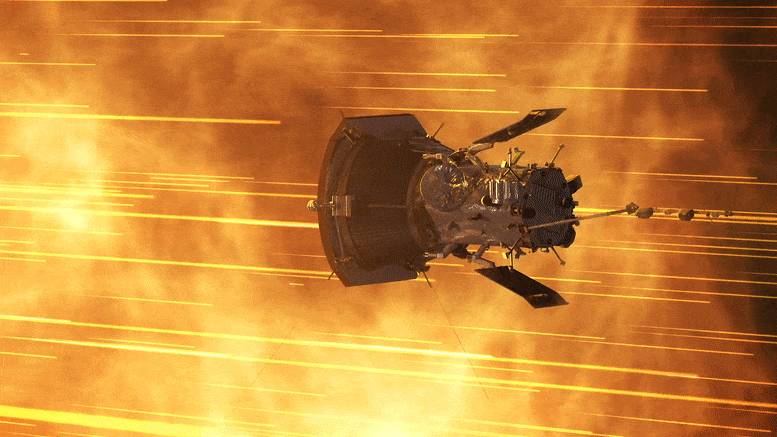On August 3, 2023, NASA’s Parker Solar Probe conducted a vital 4.5-second operation to maintain its trajectory for the sixth flyby of Venus. This modification is essential for leveraging Venus’s gravity to modify its orbit around the Sun, preparing the probe to set new records for speed and proximity to the Sun on September 27, 2023. Credit goes to NASA GSFC/CIL/Brian Monroe.
On the aforementioned date, NASA’s Parker Solar Probe carried out a brief adjustment that ensured the spacecraft remained aligned with the target point for its sixth approach to Venus, scheduled for Monday, August 21, 2023.
Utilizing commands pre-set by mission control at the Johns Hopkins Applied Physics Laboratory (APL) in Laurel, Maryland, the probe activated its diminutive thrusters for a span of 4.5 seconds. This allowed for a 77-mile alteration in its path and quickened its closest encounter with Venus by 1.4 seconds. The exact timing and position are vital for this flyby, which is the sixth out of a planned seven, where the probe will utilize Venus’s gravity to draw its orbit nearer to the Sun.
Yanping Guo, mission design and navigation manager at APL, noted, “Though Parker’s velocity of about 8.7 miles per second may make this trajectory correction maneuver seem minor, it’s essential to secure the necessary gravity assist at Venus, substantially altering Parker’s speed and distance to the Sun.”
When the Parker Solar Probe comes within 4.5 million miles of the Sun’s surface, it will reach a speed of 394,742 miles per hour, surpassing its own record for velocity and solar distance on September 27, 2023.
An artistic depiction shows the Parker Solar Probe spacecraft nearing the sun. Credit: NASA/Johns Hopkins APL/Steve Gribben
Launched in 2018, the Parker Solar Probe is a NASA mission purposed to investigate the Sun’s outer atmosphere, or corona. The probe is focused on examining the mechanics of the solar wind, magnetic fields, and energetic particles in the corona. By approaching the Sun more closely than any spacecraft before, the Parker Solar Probe offers unparalleled insights into how the Sun influences the solar system. The data collected by the probe advances our grasp of fundamental solar and space physics, with potential impacts on space weather prediction and understanding the behavior of other celestial bodies.
Table of Contents
Frequently Asked Questions (FAQs) about Parker Solar Probe
What was the purpose of the 4.5-second maneuver performed by NASA’s Parker Solar Probe on August 3, 2023?
The maneuver was executed to keep the spacecraft on course for its sixth Venus flyby. By adjusting the trajectory by 77 miles and speeding up the closest approach to Venus by 1.4 seconds, it allowed the probe to use Venus’s gravity to alter its orbit around the Sun. This set the stage for the probe to break its own speed and solar distance records on September 27, 2023.
Who was responsible for the operation and control of the maneuver?
The operation was conducted using preprogrammed commands from mission control at the Johns Hopkins Applied Physics Laboratory (APL) in Laurel, Maryland.
What records is the Parker Solar Probe expected to break?
The Parker Solar Probe is expected to break its own records for speed and proximity to the Sun, reaching 394,742 miles per hour and coming within just 4.5 million miles from the Sun’s surface on September 27, 2023.
What is the main mission of the Parker Solar Probe?
Launched in 2018, the Parker Solar Probe’s main mission is to study the Sun’s outer atmosphere or corona. It aims to gather data on the dynamics of solar wind, the magnetic fields, and energetic particles in the corona, providing unprecedented insights into how the Sun affects the solar system.
How will the Parker Solar Probe’s observations impact our understanding of space?
The observations made by the Parker Solar Probe contribute to our understanding of fundamental solar and space physics. This can have implications for space weather forecasting and deepen our knowledge of the behavior of other stars.
More about Parker Solar Probe
- Parker Solar Probe’s Official Website
- Johns Hopkins Applied Physics Laboratory
- NASA’s Overview of the Parker Solar Probe Mission
- Parker Solar Probe’s Venus Flybys



5 comments
i heard about this but didn’t know all the details. this article helped alot. really hope they gather some cool info from the sun. Go NASA!
Wow, this Parker Solar Probe is somethin else! Cant believe it’s making its 6th Venus flyby. Whats next? Space tech is just amazing!!!
Who else is excited for the speed and solar distance records? i mean, this is history in the making. can’t wait for Sept 27. Go Parker!
Science and techonology never fail to impress. It’s like a sci-fi movie but real life. Kudos to everyone involved in this mission. the future is now!
the probe is going how fast?? 394,742 miles per hour, thats insane. keep breaking those records NASA! I love following all this space stuff, it’s the future